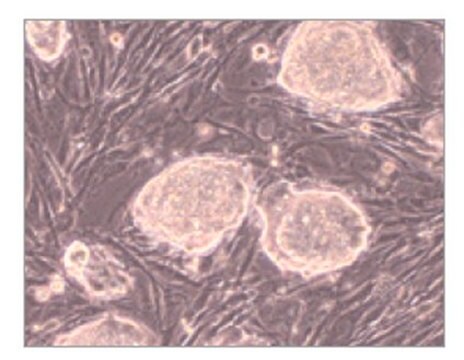推薦產品
一般說明
Plating MEF Feeder Cells
Procedure:
1. Prior to thawing PMEF feeder cells, coat plates/flasks with Gelatin solution.
2. Thaw PMEF vial(s) quickly in a 37 °C water bath and transfer to a 15 mL tube (already containing 10 mL of warm PMEF Feeder Cell Medium). Gently invert the tube to distribute, and centrifuge at 300 xg for 4–5 minutes.
3. Remove supernatant and resuspend the cell pellet in warm PMEF Feeder Cell Medium.
4. Remove the Gelatin solution from plates/flasks, and aliquot the PMEF feeder cell suspension at the densities recommended in Table 4.1 of the mouse ES protocol guide
5. Incubate the PMEF Feeder cells at 37 °C with 5% CO2. Use Figures 4A, B and C in the mouse ES protocol guide as a guide for an estimate of correct PMEF density and
appearance. Gelatinized plates may be used for 12–14 days.
Procedure:
1. Prior to thawing PMEF feeder cells, coat plates/flasks with Gelatin solution.
2. Thaw PMEF vial(s) quickly in a 37 °C water bath and transfer to a 15 mL tube (already containing 10 mL of warm PMEF Feeder Cell Medium). Gently invert the tube to distribute, and centrifuge at 300 xg for 4–5 minutes.
3. Remove supernatant and resuspend the cell pellet in warm PMEF Feeder Cell Medium.
4. Remove the Gelatin solution from plates/flasks, and aliquot the PMEF feeder cell suspension at the densities recommended in Table 4.1 of the mouse ES protocol guide
5. Incubate the PMEF Feeder cells at 37 °C with 5% CO2. Use Figures 4A, B and C in the mouse ES protocol guide as a guide for an estimate of correct PMEF density and
appearance. Gelatinized plates may be used for 12–14 days.
The EmbryoMax range of PMEF cells provides researchers with a convenient solution for ES cell culture by eliminating the need for time consuming feeder cell isolation and preparation. Many embryonic stem cell culture protocols necessitate the use of primary mouse embryo fibroblast (PMEF) cells. In these protocols, ES cells are typically cultured on a monolayer of PMEF feeder cells. Feeder cells perform two important roles in stem cell culture: they secrete several important growth factors into the medium, which help maintain pluripotency, and they provide a cellular matrix for ES cells to grow.
The DR4 strain of MEF feeder cells are resistant to neomycin, hygromycin, puromycin, and 6-thioguanine. They are mitotically arrested by mytomycin-C treatment and will not proliferate.
The DR4 strain of MEF feeder cells are resistant to neomycin, hygromycin, puromycin, and 6-thioguanine. They are mitotically arrested by mytomycin-C treatment and will not proliferate.
細胞系描述
Primary Mouse Embryo Fibroblasts
成分
EmbryoMax PMEF, P3, Strain DR4, Mito-C Treated: (Part number PMEF-DR4) One (1) vial containing ≥4 x10^6 cells per vial.
品質
Cell Viability and Morphology: PASSED
Mycoplasma Testing: PASSED
Bacterial Testing: PASSED
Fungi Testing: PASSED
Mycoplasma Testing: PASSED
Bacterial Testing: PASSED
Fungi Testing: PASSED
儲存和穩定性
Vials should be stored in the vapor phase of liquid nitrogen.
法律資訊
EmbryoMax is a registered trademark of Merck KGaA, Darmstadt, Germany
儲存類別代碼
12 - Non Combustible Liquids
水污染物質分類(WGK)
WGK 1
閃點(°F)
Not applicable
閃點(°C)
Not applicable
分析證明 (COA)
輸入產品批次/批號來搜索 分析證明 (COA)。在產品’s標籤上找到批次和批號,寫有 ‘Lot’或‘Batch’.。
我們的科學家團隊在所有研究領域都有豐富的經驗,包括生命科學、材料科學、化學合成、色譜、分析等.
聯絡技術服務


